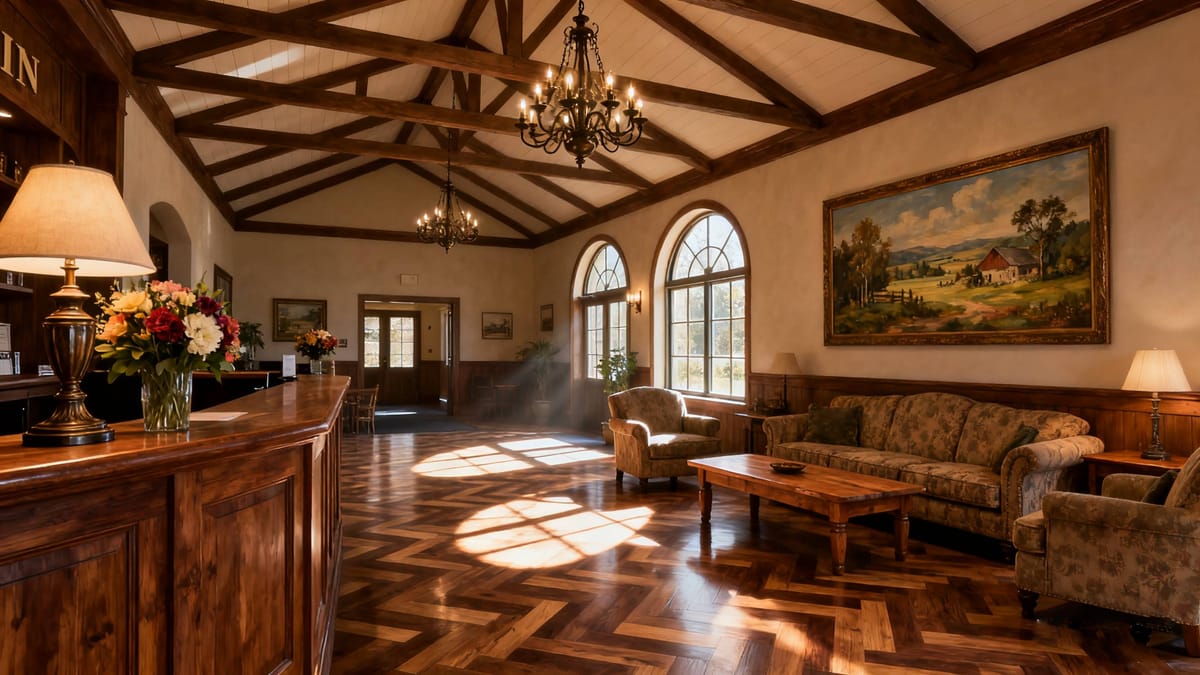Running an inn can be a great way of life and a good business. Inns feel like home but run like a proper place to stay. People pick inns because they’re charming, offer personal service, and have a special character you don’t find in big hotels. For owners, it’s not just about giving someone a bed. It’s about making moments guests remember, so they come back and tell others about it.
What is an Inn?
An inn is a small place to stay. It usually offers rooms, breakfast, and maybe extras like a lounge or outdoor space. Most inns have fewer rooms than hotels—often under 20. This lets innkeepers give guests really personal attention. Many inns are family-run and found in pretty towns, the countryside, or near spots people love to visit.
Travelers choose inns for their unique feel. Each inn shows the owner’s style and the local culture. Unlike chain hotels that all look the same, inns have their own personality. That’s why people who want a real, local experience like them.
How is an Inn Different from a Hotel?
Both inns and hotels give you a place to sleep, but they’re not the same:
- Size: Hotels can have hundreds of rooms. Inns are much smaller, usually with less than 20.
- Feel: Inns are cozy and homey. Hotels often feel more formal or like every other hotel.
- Services: Hotels might have big restaurants, gyms, or meeting rooms. Inns focus on the basics—comfy rooms and breakfast. Some inns add special touches like local tours or home-cooked meals.
- Talking to Guests: Innkeepers often chat directly with guests, building a friendly connection. In hotels, you usually deal with different staff for quick, business-like talks.
- Cost and Value: Inns can cost less than mid-range or fancy hotels. You get good value because of the personal care.
These differences show why inns are still a top choice for travelers wanting something different from a standard hotel stay.
Key Steps to Running an Inn Business
Develop a Business Plan
A detailed plan gives direction and ensures financial stability. It should outline your target market, pricing strategy, expected expenses, and revenue projections. Identify whether you want to attract leisure travelers, business guests, or families. A clear plan also helps secure funding if external financing is needed.
Select the Right Location
Starting an inn usually begins with choosing a property. One way is to buy an inn that’s already running. This saves time since the place already has a setup, regular guests, and a name. Just be sure to check the money records and look over the building carefully to avoid surprise repair bills.
The other way is to buy a property and turn it into an inn yourself. This gives you full control over how it looks and works, but it costs more money at the start, takes longer to fix up, and means building a new reputation from scratch.
No matter which way you go, location is key. Inns near national parks, historic spots, or pretty drives tend to bring in guests regularly. Easy access matters too – safe surroundings and simple travel options really affect how happy guests are. Before you buy, look into local zoning rules, permits, and other regulations so you don’t run into problems later.
Get the Inn Ready
Guests want a place that’s clean, comfy, and feels nice. Rooms need good beds, working bathrooms, and solid internet. A shared space like a lounge or garden adds charm and gives folks a place to relax. How you decorate should match your inn’s style – maybe cozy, modern, or classic. Little things like local art or a menu for homemade breakfasts can make guests remember their stay.
Get the Right Licenses and Permits
Running an inn means getting the proper paperwork. What you need depends on where you are. This usually includes a lodging permit, passing health and safety checks, and registering for taxes. You’ll also need liability insurance to cover accidents. Getting this done right makes guests trust you and helps you avoid big fines.
Set Up Your Operations and Tech
Good systems make your life easier and keep guests happy. Use booking management software to handle reservations, track rooms, and take payments. Connect with OTAs like Booking.com or Expedia so more people see your inn. A property management system(PMS) tool that syncs your listings across different sites is really helpful – it stops you from accidentally booking the same room twice. Even small inns save time and headaches with these digital tools.
Marketing and Guest Acquisition
A good website is key. Use clear, nice photos and simple descriptions. Make sure people can book directly with you – it looks more professional. Learn basic SEO so travelers can find you when they search online. Use social media to show off what makes your place special and talk to potential guests. Team up with local spots – like nearby restaurants, attractions, or tour guides. They can send guests your way. Offering deals or packages (like dinner + a room) gives people extra reason to pick you over other places.
Focus on Guest Experience
Running an inn is all about being friendly. Getting to know guests, answering questions fast, and noticing small things makes them want to come back. Clean rooms, fresh sheets, and a good breakfast are expected. But doing a little extra makes your place special. Remembering what a guest likes or suggesting fun local spots helps build real connections.
Ask guests to share their thoughts online. Good reviews help more people find you. Helpful feedback shows where you can improve. Keeping a good reputation matters for getting bookings.
Challenges of Running an Inn Business
Owning an inn feels great, but it’s not always easy. Busy times and slow seasons mean you need to plan your money carefully. Standing out from hotels, vacation rentals, and other inns takes creativity.
Paying for power, staff, and upkeep can be hard. You need to give great service while still making money. Bad reviews or surprises—like broken things or last-minute cancellations—can cause problems. Smart owners save up for emergencies, try different ways to reach guests, and stay ready to adapt.
Tips for Long-Term Success
- Keep learning about hospitality trends and guest expectations.
- Use technology to streamline booking, communication, and check-in processes.
- Maintain high cleanliness and safety standards at all times.
- Build community connections to strengthen your brand identity.
- Listen to guest feedback and adjust services accordingly.
These practices help ensure the inn remains competitive, profitable, and memorable for visitors.
Conclusion
An inn isn’t just a bed for the night. It’s a place where visitors get to experience the local area and enjoy friendly, personal service. Running an inn takes real planning, hard work, and a genuine desire to make guests happy. If you pay attention to the right things – like picking a good spot, getting the place ready, following the rules, using helpful tech, spreading the word, and keeping guests satisfied – you can build a business that works well and makes both you and your guests happy.
Do it right, and an inn can be a good business that makes money while letting you meet people from all over the world.

